VRF Systems
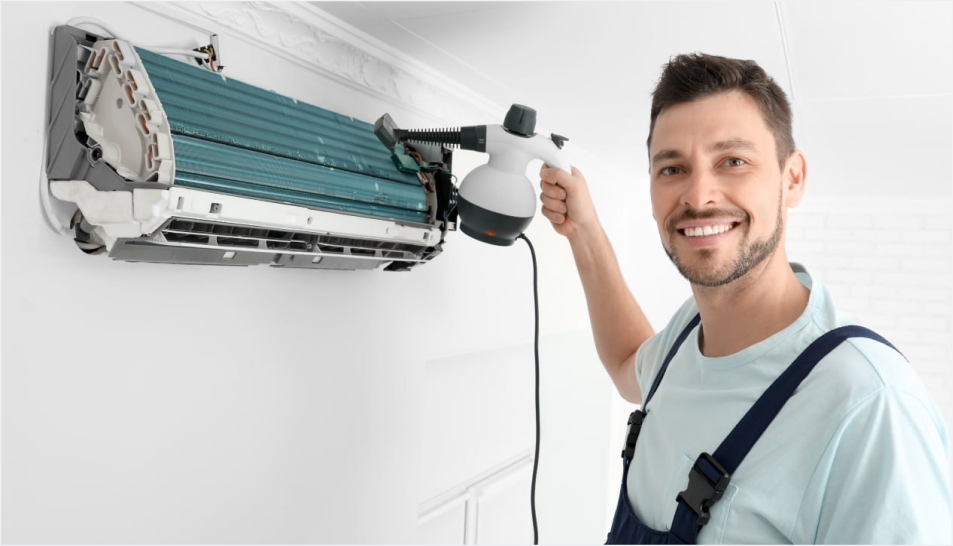
Cooling You Can Count On
Fast and efficient installation of new air conditioning units. Our certified technicians ensure your system is properly installed for optimal performance Site assessment, equipment delivery air an complete installation.
Regular maintenance services to keep your air conditioning system running smoothly and for as efficiently, preventing an breakdowns and extending its lifespan Filter replacement, coil cleaning, refrigerant check, thermostat calibration, and system inspection air conditioning Upgrading your existing air conditioning system.
Your Comfort, Our Mission
Upgrading your existing air conditioning system to more energy-efficient models, helping you save on energy bills and reduce your carbon footprint Lubrication of moving parts, electrical connection inspection,
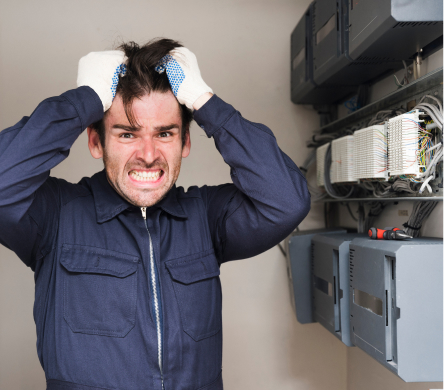
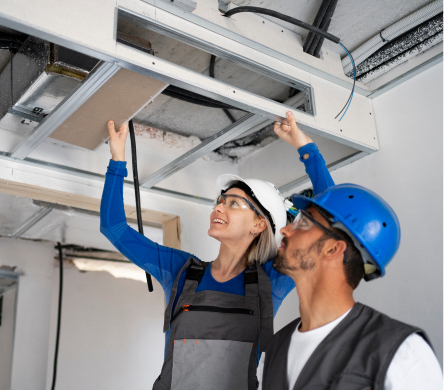
Energy assessment, old unit removal, new unit installation, and energy efficiency optimization a Advanced diagnostic services using the latest technology to detect and address issues in your air conditioning system before they become major problems
Air Conditioning & Heating Services
Comprehensive system scan, fault detection, detailed report, and recommended solutions. Tha Precision calibration services to ensure your air conditioning system is operating at its optimal settings for maximum comfort and efficiency
- Precision Installations
- FrostWave Duct Cleaning
- CoolCare Maintenance
- CoolFlow Inspection
- TempGuard Emergency
- FrostGuard Inspection
We help you with the dedication & affection
Thorough cleaning services to remove dirt, dust, and debris from your air conditioning system, improving air quality and system efficiency
How often should I have my air conditioner serviced?
It is recommended to service your air conditioner at least once a year to ensure it runs efficiently and effectively. Common signs include unusual noises, weak airflow, warm air instead of cool, and a sudden increase in energy bills.
What are the signs that my air conditioner needs repair?
It is recommended to service your air conditioner at least once a year to ensure it runs efficiently and effectively. Common signs include unusual noises, weak airflow, warm air instead of cool, and a sudden increase in energy bills.
How can I improve the efficiency of my air conditionin
It is recommended to service your air conditioner at least once a year to ensure it runs efficiently and effectively. Common signs include unusual noises, weak airflow, warm air instead of cool, and a sudden increase in energy bills.
What size air conditioner do I need for my home?
It is recommended to service your air conditioner at least once a year to ensure it runs efficiently and effectively. Common signs include unusual noises, weak airflow, warm air instead of cool, and a sudden increase in energy bills.
Categories
Downloads
Ask Question
Variable Refrigerant Flow (VRF) systems are advanced HVAC solutions that provide precise temperature control by regulating refrigerant flow to multiple indoor units from a single outdoor unit. Unlike conventional HVAC systems, VRF operates with inverter-driven compressors, which continuously adjust refrigerant flow based on real-time demand, leading to enhanced energy efficiency, reduced operational costs, and improved occupant comfort. These systems eliminate frequent start-stop cycles, reducing power surges and wear on components, ultimately extending the system’s lifespan. VRF technology utilizes electronic expansion valves (EEVs) to modulate refrigerant distribution, ensuring optimal heat exchange and minimizing energy losses. VRF systems are classified into heat pump VRF, which provides either cooling or heating to all zones at a given time, and heat recovery VRF, which allows simultaneous heating and cooling by transferring excess heat from areas requiring cooling to those needing heating, significantly improving overall efficiency. Additionally, water-cooled VRF systems use water loops for heat rejection, making them suitable for large commercial and high-rise buildings where air-cooled condensers may be impractical.
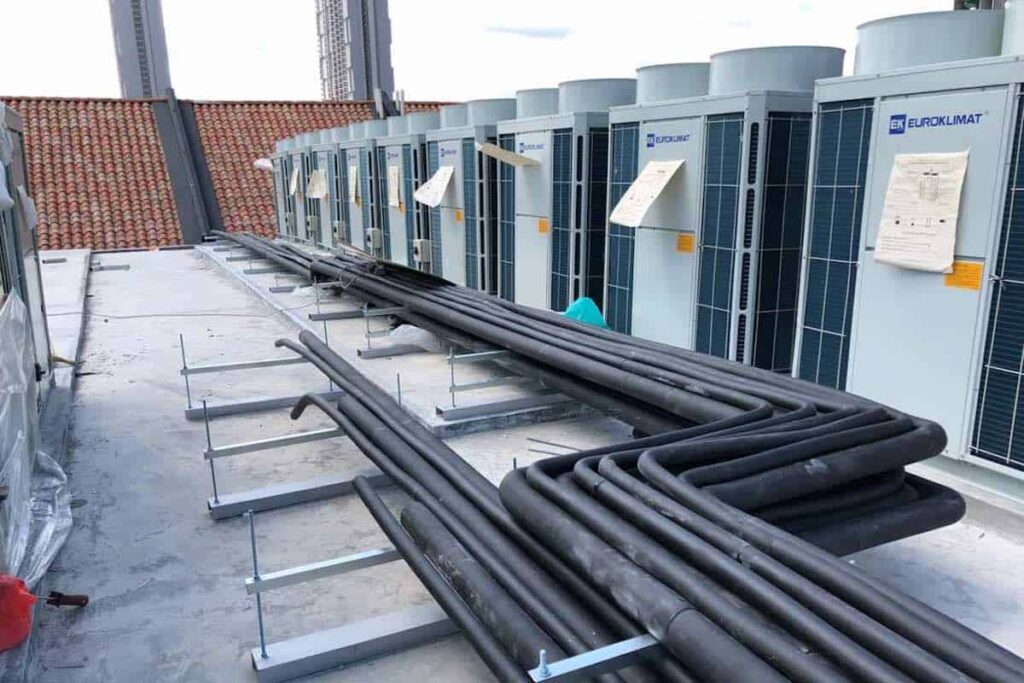
Working Principle of VRF Systems
VRF systems use a modulating, variable-speed compressor that adjusts the amount of refrigerant delivered to indoor units based on real-time demand. The electronic expansion valves (EEVs) regulate the refrigerant flow, ensuring efficient heat exchange between the evaporator and condenser. These systems typically use R-410A refrigerant due to its high energy efficiency and environmental compliance.
- Compressor Modulation:
- Unlike fixed-speed compressors, VRF systems use an inverter-driven scroll or rotary compressor that continuously adjusts its speed to match the cooling or heating load.
- This modulation reduces power consumption and prevents frequent start-stop cycles, improving system lifespan.
- Refrigerant Distribution & Control:
- A VRF system consists of multiple indoor units connected to a common refrigerant circuit, controlled through a branch selector unit (in heat recovery systems) or direct refrigerant piping.
- Each indoor unit operates independently using EEVs, which modulate refrigerant flow based on temperature setpoints and thermal loads.
- Heat Transfer & Recovery Mechanism:
- Heat Pump VRF: Operates in either cooling or heating mode for the entire system.
- Heat Recovery VRF: Simultaneously provides cooling and heating by transferring heat from zones requiring cooling to those needing heating, enhancing energy efficiency up to 30% over conventional systems.
- Advanced Controls & Automation:
- Building Management System (BMS) Integration: VRF systems communicate with BMS via BACnet, Modbus, or LonWorks protocols for centralized monitoring and control.
- IoT & Smart Sensors: Advanced systems incorporate temperature, humidity, occupancy, and CO2 sensors to optimize energy usage dynamically.
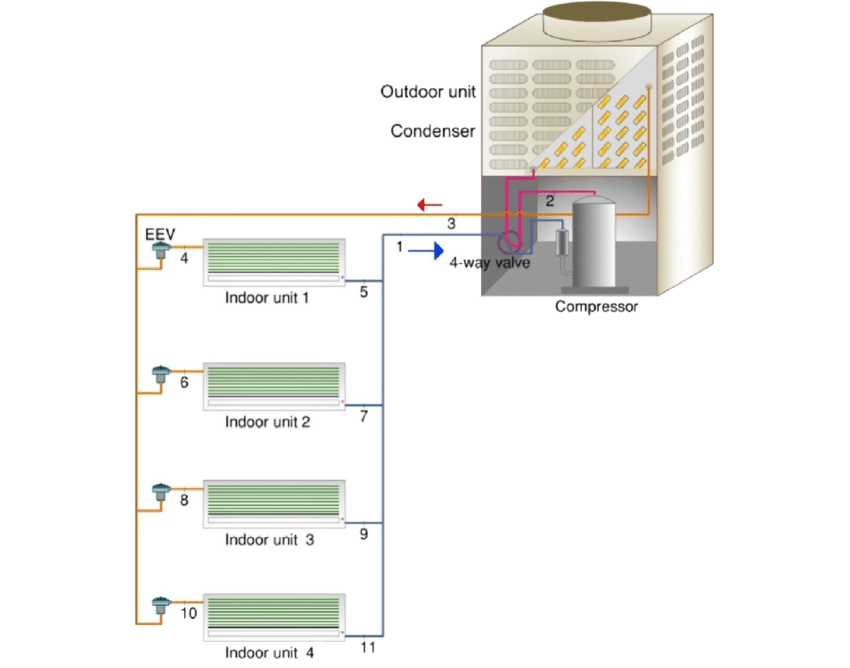
VRF systems also support long refrigerant piping runs (up to 1,000 feet), providing design flexibility for complex building layouts. Their zoning capabilities enable independent climate control for different areas, minimizing energy wastage while enhancing user comfort. These systems are widely used in commercial buildings, hotels, hospitals, data centers, educational institutions, and mixed-use developments due to their quiet operation, low maintenance, and year-round heating and cooling capabilities. Offering up to 40% energy savings over traditional HVAC systems, VRF represents the future of sustainable, cost-effective, and intelligent climate control solutions for modern buildings.
